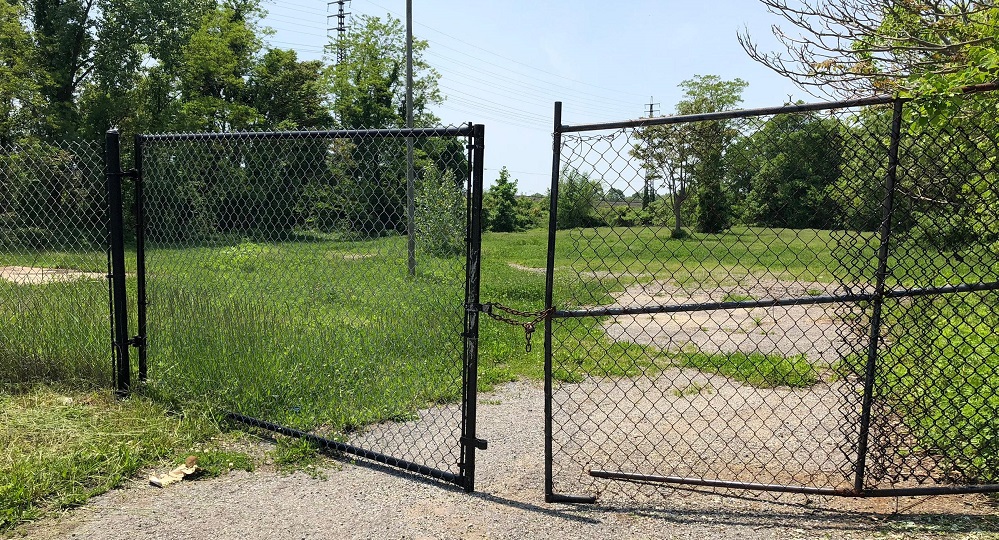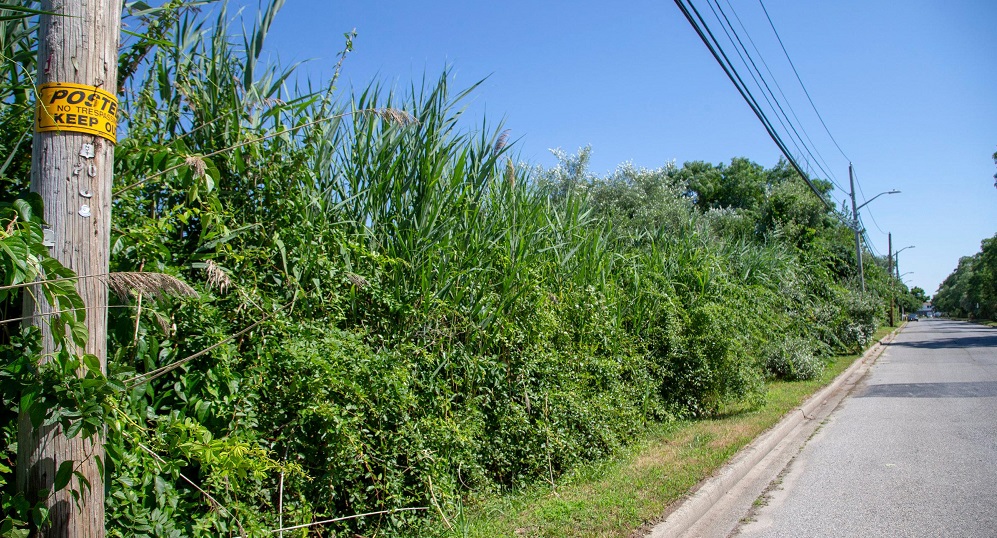Long Island contractors Gina Cantone-Centauro, left, her husband Vincent Centauro, right, and her brother Michael Cantone, take a selfie with the Tribble brothers after revealing their remodeled Wyandanch home on June 25. Photo credit: Danielle Silverman
Gina Cantone-Centauro, her brother, Michael Cantone, and her husband, Vincent Centauro, have been repairing and remodeling homes across the Island for more than a decade.
But for the past two years, the trio who run the Franklin Square-based home remodeling business Truly Unique Designs has been doing it for free.
“Families would call us to repair a bathroom, but when we’d get there, we’d find out that the need was actually far greater,” said Cantone-Centauro, 47, who explained the financial struggles of working-class people hit close to home for the couple, who at the time were taking care of two of their parents who were sick. “And we’re not referring to repairs of a frivolous or aesthetic nature, we’re talking living conditions. In those situations, Vinny and I would just make the decision to go ahead and fix whatever else needed repairing.”
And would always do so at no additional cost.
“Until finally, one morning I woke up,” Vincent Centauro, 39, said, “turned to Gina and said ‘Hey, I have an idea!’ and that’s when I told her about creating a nonprofit, and of course she and, later, Michael were both onboard.”
The Franklin Square couple then hired an attorney to help them navigate the process of creating Rescuing Families Inc., a nonprofit aimed at helping disabled and disadvantaged Long Islanders by providing free home repair and remodeling services. They sent an email blast about their new project to all their contacts and posted about it on Facebook.
“We wanted to test the waters and kind of put the word out about what we were trying to do,” Cantone-Centauro said.
She described what came next as “overwhelming.”
“It was like the floodgates had opened,” she said. “I must’ve gotten more than a hundred emails from people who were asking for help, and once I posted a formal application, I got about 400.”
The Rescuing Families Inc. application includes a background check that involves looking into the applicant’s criminal and financial history. The purpose is to eliminate homes set for short sale or foreclosure as well as applicants who are not seeking employment or who are unwilling to be treated for addiction.
But despite the volume of applicants, choosing that first family to help was, “considering the conditions this family was living in,” said Cantone-Centauro, “not hard at all. It was a unanimous decision.”
Tribbles in trouble
Karla Benavides has worked for three years as an independent broker, creating budgets and daily living plans for people with disabilities and whose work is overseen by state agencies like the New York Office for People with Developmental Disabilities.
She was contacted in May 2016 by Bruce Tribble’s Medicaid service coordinator. About 30 years ago Tribble, 59, who has cerebral palsy, sustained a head injury that left him unable to walk. He now uses a motorized wheelchair.
Bruce Tribble’s Medicaid service coordinator, who is designated by the state to assist people with developmental disabilities by advocating for services they need, reached out to Benavides to coordinate an individualized plan that would help him maximize his independence.
“There was no way I could move on without trying to do something to help them.”
–Karla Benavides
Tribble was at the time living with his brother, John Tribble III, 58, in their deceased parents’ Wyandanch home.
“I took the case and visited the home,” Benavides said.
“It was a lot to take in. It was not livable,” she said. “There was no heat. No kitchen. They were living out of basically only one room, the living room. It was almost as if they were living in an abandoned home.”
Benavides said she was startled by the amount of debris in the home, the lack of space for the brothers to safely move around in and the fact that there was no running water.
Both Tribble parents were hoarders, John Tribble said. When they died, the brothers were on their own. John, stressed by the responsibility of taking care of his disabled brother, became distracted and was fired from his job. He too started to battle a hoarding addiction.
“John had made a contraption using a bucket so that Bruce could go to the bathroom because he couldn’t lift him from his wheelchair by himself,” Benavides said. “There was no way I could move on without trying to do something to help them.”
Benavides then learned about Rescuing Families and emailed Cantone-Centauro to tell her about the Tribbles. She urged John Tribble to apply, which he did.
And he sent pictures.
Route to rebuilding
Rescuing Families Inc. started working on the Tribble home in May 2017, almost a year after Benavides’ initial visit.
“Before we could start working on the renovation we had to cut through a lot of red tape,” said Cantone-Centauro. “We had to prove our intentions and our nonprofit status to several state organizations involved with Bruce’s care before we could even step foot in the house to as much as begin removing garbage.”
The impending renovation shed light on the Tribble brothers’ living situation and led Adult Protective Services to declare the property uninhabitable and to remove Bruce Tribble from the home in April 2017, Cantone-Centauro said.
He was then placed in the care of Hauppauge-based nonprofit Home Injury Associates and now lives in a group home. Despite being crushed by the separation from his brother, John Tribble continued living in the home throughout the rebuilding process.
Cantone-Centauro, her husband and brother, along with about eight volunteers, worked on the Tribble home renovation for 296 days, collectively clocking in more than 1,000 volunteer hours.
Together they rid the house of 12 dump trucks’ worth of debris and garbage, removed hazardous wooden structures and contraptions John made to facilitate life for Bruce, removed the garage, which had been condemned, and gutted the inside of the house to make it wheelchair accessible.
“The home also had a leaky roof, so there was mold and severe water damage throughout the inside of the house,” Michael Cantone said.
Asking for help
The group went door to door asking other small-business owners to donate materials and time to complete the project. But Cantone said they were “turned down a lot.”
“It was frustrating,” Centauro said. “Some people said they would help us but didn’t. They either wouldn’t show up or would suddenly stop returning our calls.”
However, many businesses did step up, among them Cancos Tile, a Farmingville-based company that donated tile, countertops and sinks, and Green Art Plumbing, in Freeport, which donated plumbing fixtures.
V. Guinta & Son Roofing Co., based in Franklin Square, installed the roof, and students from the Electrical Training Center, in Copiague, rewired the house.
“For us, it meant long work hours at the home, less time dedicated to our business, late payments on our own mortgage . . . it was a bit stressful, but we got it done.”
–Gina Cantone-Centauro
“Once we met with Gina and learned about the work they were doing, we knew we wanted to help in any way we could,” said Bernadette White, co-owner of Cancos Tile. “We thought it was such a great cause.”
Sue Viscardi, 58, of New Hyde Park, met the Cantone-Centauros through mutual friends and has volunteered with Rescuing Families for about 18 months. She has mainly assisted the nonprofit with fundraising at its monthly yard sale, setting up and breaking down, and in the time leading up to each event, picking up and dropping off donations.
“What’s really struck me is how unaware Gina and Vinny are of how much they’re really helping people,” Viscardi said. “They like to say they’re doing it one home at a time, but it’s not true. A family who had just gotten out of Section 8 [housing] had moved to a new apartment but had nothing. The children were sleeping on pillows on the floor. They came to the yard sale and Gina gave them the couch they were looking to buy. I mean, she and Vinny practically furnished their place and delivered the items to them, too.”
Another volunteer, Mary Attianese, 58, of Valley Stream, said volunteering with Rescuing Families has given her an opportunity to give back despite not being financially well-off herself.
Along with a few other volunteers, Attianese spent about five nights cleaning and polishing items found in the debris inside the Tribble home.
Some of the items salvaged included dishes, pots and pans, artwork done by John and Bruce’s mother, and smaller things like Matchbox cars and Smurf figurines.
“Every night I came home drained, but fell asleep with a full heart,” Attianese said.
The Cantone-Centauros said they invested $110,000 of their own money to repair the property and that completing the renovation took “sheer determination and sacrifice.”
“Towards the end it was really tough. It was one big push by a small group of people,” Cantone-Centauro said. “For us, it meant long work hours at the home, less time dedicated to our business, late payments on our own mortgage … it was a bit stressful, but we got it done.”
The big reveal
When the long-awaited day of the big reveal finally came in late June, Rescuing Families invited the small-business owners and volunteers who helped along the way to attend.
But it’s safe to say that no guest was as special as Bruce Tribble. And no one present was as excited to see him as John was.
“It’s different for me because I lived it every step of the way,” John Tribble said. “What I’m really excited about is having my brother here and having him see everything. Yeah, having my brother here, that’s what’s special.”
It was easy to see by the constant smile on Bruce’s face and the way he doted on John that the feeling was mutual.
The nonprofit’s founders surprised Bruce, a big-time sports fan, with a New York Knicks-decorated room, a fully handicap-accessible bathroom and shower, living room area and outside ramp.
“Me? I had a dream about this,” Bruce Tribble said. “In my spirit, I helped John with the house. Me and John did the whole thing together. Right now, I’m happy.”
And though for now, Bruce Tribble is to continue living in the group home, he can visit the home whenever he likes.
“We can watch movies or go to church,” John Tribble said. “It’s just nice knowing he can come over again.”
As John Tribble moves forward with his new life, he continues to be mentored by Suffolk County Deputy Police Commissioner Risco Mention-Lewis.
Through the Council of Thought and Action (COTA), a support group in Wyandanch for the formerly incarcerated that she founded 10 years ago, Mention-Lewis has helped John Tribble deal with some of his deep-rooted emotional issues. Since joining COTA, Tribble has gotten free job training, professional clothes for interviews and, eventually, work.
“John has said that Head Injury Associates is helping Bruce, Rescuing Families is rebuilding their home and that COTA is helping him rebuild himself,” Mention-Lewis said.
“But what this family [Gina, Vincent and Michael] has done, it goes above and beyond just the house,” she said. “What they’ve done is life-changing, it was the catalyst, the spark that got everything else going. Before this, John was surviving. They gave him an opportunity to live.”
VOLUNTEER SPOTLIGHT
When Gil Melograno met Gina Cantone-Centauro and her husband, Vincent Centauro, founders of the nonprofit organization Rescuing Families Inc., for the first time and began volunteering with them, he was already performing a service the couple described as “admirable.”
“Gil came to us in an odd capacity,” Cantone-Centauro said.
“He originally came to the house because he works with a disabled young man who wanted to volunteer, and then instead of leaving, decided to stay and consistently gave us his 110 percent commitment and support.”
Melograno, 51, of Smithtown, is a support staff member with Hauppauge-based Independent Support Services, a company that provides self-directed services and acts as the fiscal intermediary to people with developmental disabilities throughout New York State.
He’s been with the company for about five years and has worked with people with developmental disabilities for the past nine. Empowering people with disabilities to improve the quality of their own lives is his passion, Melograno said.
It was through his work with Chris Silverman, 31, of Bohemia, that Melograno became involved with the project. Melograno said he assists Silverman “with a range of daily living activities, including budgeting, cooking and preparing meals, job applications, if need be, and transportation to and from events and volunteer opportunities like the one with Gina and Vinny.”
Melograno said he dug right into the project the first day he drove Silverman to volunteer at the Rescuing Families’ job site in Wyandanch. And he stayed the course, volunteering alongside Silverman for the duration.
“Gil did not have to do any of the work he did,” Cantone-Centauro said. “He jumped in without knowing us, worked his butt off, and was on-site every other day, laying gravel, breaking concrete, and even took it upon himself to pay for and rent a jackhammer that we needed to get some work done.”
Melograno also helped with the nonprofit’s fundraising efforts, picking up and dropping off donations that were then sold at a monthly yard sale at the Cantone-Centauro home in Franklin Square.
Cantone-Centauro and her husband said Melograno’s ability to motivate the crew to bounce back from long hours working on home renovations, with humor and genuine concern for others, made him a pleasure to be around.
Melograno often surprised the couple by bringing them food on days when they barely got a minute to break for lunch.
“He’s just so caring and selfless,” Cantone-Centauro said.
Melograno said he’s unsure that he’s deserving of such glowing adjectives, but he’s eager to dive into the next Rescuing Families project. “My chain saw is ready,” he said.
SIGN ME UP
There are many opportunities for volunteers who would like to help Rescuing Families Inc. carry out its mission of providing free home renovating and remodeling services to people in need.
Volunteers can participate in such home-renovation activities as painting, cleaning and rebuilding alongside Rescuing Families staff; may assist in such fundraising efforts as picking up, dropping off and sorting items donated by the community to be sold at Rescuing Families’ monthly yard sales; participate in setting up and breaking down activities on yard-sale days; and participate in other charity fundraising events.
Volunteers must be at least 16, fill out an application given to them by nonprofit staff, and complete a one-hour on-site safety training before working on any project. Wearing rugged, closed-toe shoes, such as sneakers or work boots, is also required. Protective work gear, such as gloves, ear and eye protection, will be provided by staff and must be worn at the job site.
Construction experience is preferred but not required; “a willingness to work and a team spirit” are, said Gina Cantone-Centauro, a co-founder of the group.
FUNDRAISING ACTIVITIES will be held throughout the year and include:
-An all–you–can–eat “Barbeque Bash” on Aug. 4 at 1010 Lewiston St., Franklin Square. The event will run from 6 to 10 p.m. Tickets are $20.
-Charity yard sales from 10 a.m. to 5 p.m. Sept. 15 and 16 and Oct. 13 and 14 at 1010 Lewiston St., Franklin Square.
INFO Call Gina Cantone-Centauro at 516-697-9403 or send an email to rescuingfamiliesinc@gmail.com or to info@familytotherescue.com. Volunteer opportunities can also be found through the group’s Rescuing Families Volunteers public group on Facebook.
YOU MIGHT CONSIDER . . .
REBUILDING TOGETHER LONG ISLAND an affiliate of Rebuilding Together, is a nonprofit organization dedicated to repairing homes and revitalizing communities. The work now done by the group started in Midland, Texas, in 1973 and began with the simple act of neighbors helping neighbors. In 1988, Rebuilding Together opened its national office. The nonprofit now has 132 affiliates across the nation.
Volunteer opportunities include carpentry, electrical, painting and plumbing work. On-site training is provided for skilled and unskilled workers. Volunteers, who can perform home visits to assess the needs of selected families, are needed.
Contact: 631-777-7894; rtliorg@gmail.com.
HABITAT FOR HUMANITY SUFFOLK is an independently operated organization is an affiliate of Habitat for Humanity International. The nonprofit organization works in nearly 1,400 communities across the United States and in about 70 countries. Its mission is to bring people together to build homes and communities. Habitat homeowners help build their own homes alongside volunteers and pay an affordable mortgage.
Volunteers age 16 and older can participate in the group’s year-round building efforts and help with framing, wallboard and floor installation, wall insulation, painting and landscaping.
Contact: Habitat for Humanity of Suffolk 631-422-4828, ext. 108; outreach@habitatsuffolk.org or visit habitatsuffolk.volunteerhub.com and click on “Create New Account.”
LONG ISLAND VOLUNTEER CENTER For more volunteer information and opportunities, call 516-564-5482 or go to longislandvolunteercenter.org.


































